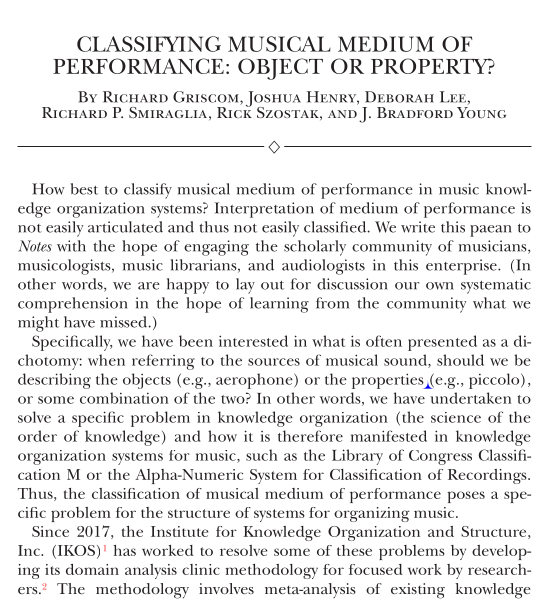Classifying Musical Medium of Performance: New Article in Notes

In 2019, I was invited by the Institute for Knowledge Organization and Structure to participate in a “domain analysis clinic” to discuss “the phenomena of music for classification.”
What does this jargon mean? In all fields of study (domains), there are characteristics, principles, and concepts (phenomena), and terms are used to describe them. In music, a piece might be written in a particular form, in a particular key, about a particular subject, or for a particular set of instruments. These are all phenomena of music.
In preparation for the clinic, we prepared a corpus bibliography and drew up preliminary lists of phenomena. The clinic was held in November 2019 at the home of the executive director of IKOS, Richard Smiraglia, in Lake Oswego, Oregon. Over two days, we discussed the phenomena of music, and during the following months we prepared our report.
One phenomenon that we found perplexing was medium of performance—the musicians and instruments needed to perform a piece of music. These can be defined either by specific instruments and voices or by performers. For example, a composer might write a piece that requires six instruments (flute, clarinet, bass clarinet, vibraphone, xylophone, cello) that are performed by four musicians (flutist, clarinetist, percussionist, cellist).
We decided to explore the phenomenon of medium of performance in more detail in an article, which was published in the March 2024 issue of Notes, the journal of the Music Library Association. Here is the abstract for the article, which may be read at DOI 10.1353/not.2024.a919032 wherever you get your scholarly journals.
How best to classify musical medium of performance? We welcome the advice and expertise of the community of Notes readers to inform our deliberations. Specifically, when referring to the sources of musical sound, should we be describing the objects (e.g., aerophone), the properties (e.g., piccolo), or some combination of the two? The Institute for Knowledge Organization and Structure convened a research group to discuss “the phenomena of music for classification.” What does it mean to classify the phenomena of music rather than musical documents or documents containing texts about music? How might we represent music apart from its documentary representations (scores, recordings, etc.)? We considered the Library of Congress Medium of Performance Thesaurus (LCMPT) and Hornbostel-Sachs (H-S) classification. The universal Basic Concepts Classification (BCC) is interdisciplinary and is organized around phenomena (things), relators (the relationships that exist among phenomena), and the properties that phenomena and relators may possess. We sought a comprehensive classification of medium of performance for the BCC. H-S focuses on the physical nature of instruments and how they make sound, the LCMPT effectively identifies specific instruments by name. H-S does not provide the level of granularity that we need but LCMPT’s larger set of terms are organized with only a few layers of hierarchy. H-S avoids local nomenclature, LCMPT embraces it. The two are attractive because they provide well-developed vocabulary and because their differences manifest as different strengths for a Semantic Web application. Ultimately our analysis reaches no specific conclusion. Instead, we have reflected thoroughly on the panoply of phenomena associated with the representation of medium of performance as phenomena of music in nondocumentary contexts.